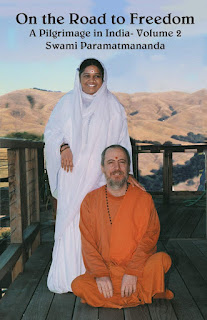On the Road to Freedom --- A Review
When I read the author's first book, which is volume 1 to this work that I am reviewing now, the author was known only as Neal Rosner, a seeker who went in search of the Truth to the Indian subcontinent, which is, in many significant ways, diverse and varied in terms of culture, beliefs, hygiene, spirituality and outlook of life in general. Yet, his search rewarded the author, who later became Swami Paramatmananda, with more than the Truth that he went in search of.
In centuries to come, and I am not being hyperbolic when I make this observation, "On the Road to Freedom" (Vols 1 and 2) will join the annals of spiritual textbooks, occupying the esteemed book shelves of aspirants and even of psychologists who set out to examine the psyche and minds of people who are honest and candid about their journey to self-discovery.
Volume two picks up where the author left off in the previous text. In his own words, Swami Paramatmananda says that in this book he starts out "to expose the reader to Ammachi's mysterious... teachings", which he gallantly has, I should say. He shares with the reader very many extraordinary nuggets of information, which most of the saint's followers are ignorant of. For instance, how her early disciples struggled both in their spiritual practice as well as in their relationship with their guru, who can easily be misunderstood to be an unmitigated jefe. Chapters two and three, in this respect, have done great justice to the task.
Chapter 4 treats of the lives of the principal disciples like Swami Amritaswarupananda, who was the saint's first sanyasi, who accepted the renounced order. What is, however, rather unusual and even disappointing is to discover that the author has purposefully left out the story of "Gayatri", the renegate who flounced out of the ashram in 1999.
In spite of her actions and subsequent heinous sins, a concise delineation of the lady, who was the first and the closest Western female disciple of the hugging saint for 20 years, would have been in order: readers, who are familiar with Mata Amritanandamayi's prophesy in one of her "Awaken, Children" that Gayatri would one day step into the shoes of her Guru, would be keen on learning what made the Australian such a revered personality, yet at the same time, propelled her to take an ignominious tumble after one score years.
There are other accounts in the book that may seem bizarre and atypical even to aspirants who are thoroughly acquainted with the ways of mahatmas and self-realised saints: one of such is the episode of Prabhakara Siddha Yogi's meeting with Mata Amritanandamayi, the protagonist around whom the narrative has been woven. His first reaction to the Guru did not corroborate the view that he was a liberated sage.
There are yet two other incidents in the book which have not been adequately explained: two so-called mahatmas, who are not known to each, had slapped the author's Guru for no rhyme or reason. Neither the author nor the hugging saint explained why the two people, whom the Guru described as highly-exalted souls, perpetrated the unseemly act.
Describing Mata Amritanandamayi's supercalifragilisticexpialidocious miracles and stupendous divine nature, the author introduced the reader to a character called Shakti Prashad, who the Guru said was "a partial incarnation of the divine mother". But nothing more was said about him. One is left to wonder what has been the fate of the young man, who has since left the ashram.
The above are but some small indentations on an otherwise smooth and inspiring narrative that is bound to motivate every aspirant who makes enormous efforts to navigate between the Scylla of spiritual life and the Charybdis of living in this world. It is an honest testimony of a sincere but serious sadhak who has attained a level of supremacy and success that is the will-o-the-wisp of pseudo-aspirants.
I may re-read Volume 1 soon.



Comments
Post a Comment